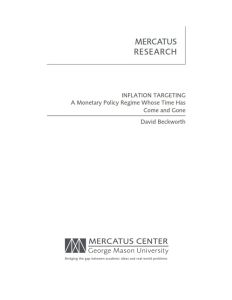Join getAbstract to access the summary!

Join getAbstract to access the summary!
David Beckworth
Inflation Targeting
A Monetary Policy Regime Whose Time Has Come and Gone
Mercatus Center, 2014
What's inside?
Was former Federal Reserve chairman Alan Greenspan just lucky during his tenure?
Recommendation
Alan Greenspan is famous for warning about the “irrational exuberance” of financial markets when he was Federal Reserve chairman. However, it was precisely his conviction that central bankers couldn’t determine when asset prices were unduly frothy that allowed one bubble after another to form and that made his successor hesitate to intervene in the run-up to the Great Recession. According to economist David Beckworth, central banking history is replete with policies – such as the gold standard and the Phillips curve – that were great successes at first but that later stumbled. getAbstract recommends Beckworth’s thoughtful look at the latest “last word” in monetary policy – inflation targeting – to economists, financial professionals and dedicated Fed watchers.
Summary
About the Author
David Beckworth is an assistant professor at Western Kentucky University.
















Comment on this summary